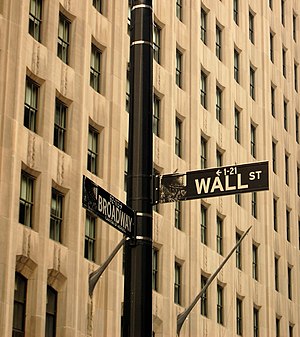 Image via Wikipedia
Image via WikipediaSimultaneously, increasing numbers of high net-worth individuals, wealth managers, institutional and other investors want to "doing good while doing well." These individuals are of the baby-boomer generation. Some have been late adopters and doubted the "depth" of this movement but clearly there is groundswell among those who want to generate return either partially or even wholly through funds or direct investments. This has led to the creation of boutique Wall St. firms which zero in on this specialization and larger financial institutions have creating small teams to focus on locating, understanding and vetting investment opportunities. As it is early, there is still conversation over whether or not impact investing is indeed an asset class or an underlying strategy which will be eventually used in all products.
Once the playground of the wealthy, or for the class of investors who could tolerate lower returns, sustainability-specialized investments are becoming available to investors of all amounts and with excellent returns. Formerly, the underlying psychology for sustainable investing ranged from some investors whose expectations are to outperform the market, to others who have a willingness to sacrifice performance for effective social impact. Today, there are products and places for investors of all sizes, goals and risk tolerances. There are boutique Wall St. firms which zero in on this specialization and larger financial institutions have created small teams to laser focus on locating and vetting investment opportunities.
Much has changed since the landmark 1987 UN-backed World Commission on
Environment and Development, which put forth the notion that "the needs of the present (must be recognized) without compromising the ability of future generations to meet their own needs." Areas of specialization within sustainable investing today include: investment areas such as adverse demography, climate change, resource depletion, global economics, and much, much more. There are direct opportunities to invest in an idea and/or funds which invest in multiple ideas and strategies.
Institutional investors ( primarily pension funds) have always taken a long-term investing approach and are now trying to integrate environmental, social and governance goals (ESG) with their longstanding inter-generational bias. ESG is a "best practice" for any size investor. Today's institutional investment SWAT teams are exploring how credit markets, banking and investment management can line-up together on the socially responsible playing field.
Outside of institutions, early adopters in impact investing have been family offices, high net worth individuals and their entities, private banks, etc. This is a hybrid investor class that is small in size, but powerful in investable dollars. In the future, powerful investment communities will be formed by uniting like-minded investors who will deploy funds readily when the parameters meet both their performance and sustainability goals. Multi-family offices or families with substantial wealth are able to influence markets through passionate investing. They function as the "trusted advisor" across financial, philanthropic and succession planning.
As with any new emerging idea, ROI benchmarks for measuring the social impact separate from dollar returns has not been met with any universally adopted formula. Qualitative analysis between metrics and results are not clear. For the time being, the feel-good "kumbaya" message is sufficient return along with some profits. Return is measured in other ways including investors who invest alongside their children and grandchildren. They choose to "measure" the benefits of modeling socially-responsible investing behaviors to family members. This, of course, is priceless.
I have written before, it's not easy being green. And we all know that it is not easy "making green." But in the future it will be. There are even courses taught at major universities in prestigious business school where the integration of public policy, philanthropic goals and passions can come together for the good of Wall Street and every street. Our future thought leaders are sitting in those classrooms and dreaming of what the interface might look like.










